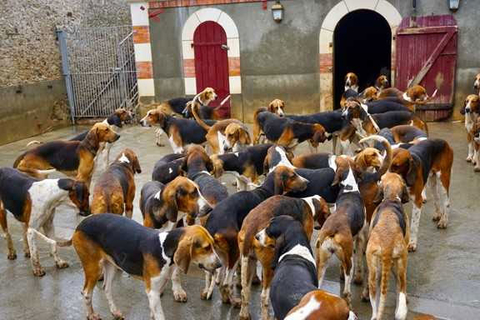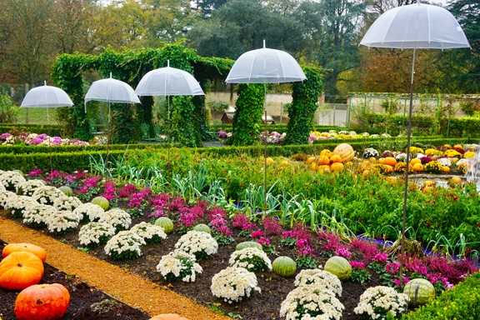Kings, queens, The Renaissance, royalty, nobility, knights, and fairy tales, are just some of the things conjured up when one mentions the chateaus of the Loire Valley in France. Once the land of over a thousand chateaus, the Loire Valley still has hundreds of chateaux, mostly privately owned, that are in use. Some have been converted to bed and breakfasts, some are wedding and party venues and approximately 50 others are open to the public to visit. You can spend days on end in the widespread Loire region chateau hopping and still not see all of them.
In November we were invited to Chateau de Cheverny in Loir-et-Cher. We took a train from the Gare Austerlitz station in Paris to Blois, a 90-minute ride. We were picked up by private car courtesy of the chateau and the scenic, 25 minute drive was filled with lush green meadows and sights of other chateaus.
We were whisked into the orangerie, where orange and lemon trees were once stored in the winter season as not to freeze, which has now been made into a reception space. A typical French breakfast of cheese and pastries and breads was served with local made jams and jellies. The Marquis Charles-Antoine de Vibraye and his wife the Marquise Constance de Vibraye, direct descendants of the original owners from over six centuries ago, privately own Cheverny and it was the first chateau to be open to the public starting in 1922. During our breakfast Charles-Antoine effusively shared the history of the chateau and its roots, while laying out our itinerary. He would also be our personal guide in many parts of our tour throughout the day.
We were taken by an open tram deep into the forest of Cheverny. It was a chilly autumn day and the trees were almost bare, with piles of yellow and burnt orange leaves lining the floor of the forest. The towering trees didn’t look like typical ones you see in the French countryside, and we learned that Paul de Vibraye imported and planted hundreds of sequoia trees from the U.S., along with lime and cedar trees between1820 and 1860.
A ride in small, open boat took us through a stream lined with plants and trees reflecting their rich foliage colors on the pea green water. Ducks, mallards and other birds were spotted on the trail.

Hunting has been a tradition in Cheverny for centuries, and today the chateau still retains a hunting team, one of the oldest in France, extending from the 1850s. Deer, stag and wild boar are the main animals hunted, and the chateau strictly adheres to the local hunting laws. Hunting is conducted twice a week from October to March.
A popular activity at the chateau is the feeding of the hunting dogs. One hundred Anglo-French hunting hounds are dispersed into outdoor kennels surrounded by high fences. As we approached the fences, the dogs started to bark and stick their snouts through metal openings.
Witnessing the feeding, we watched the dog master shoo the dogs into another area, so he could prepare their feed. Once the dogs were secured, he filled the troughs with food. Once filled, he cautiously opened the gate for the dogs to re-enter and sternly commanded them to stay still for a few moments before they were allowed to eat. Once he sent the signal, it was a feeding frenzy as the dogs fought one another to take their place in the trough.
Another fun attraction is the Tin-Tin Museum, inspired by France’s most beloved comic books. Author and creator Hergé used the chateau as the model for Marlinspike Hall, the home base of Captain Haddock, Tintin, Snowy, Professor Calculus and Nestor, the faithful butler.

A visual knockout was a beautifully planted potager/vegetable garden brimming with autumn delights. Pumpkins, massive squash, cabbage flowers, and purple, marigold, pink and white mums were neatly arranged in rows alongside herbs and pebbles.
After lunch we were invited for a tour of the inside of the chateau, constructed between 1624 and 1630 by Philippe Hurault. One of the advantages of Cheverny is that all the rooms are fully furnished, since it’s still inhabited by the family, whereas many other chateaux in the Loire stand with mostly empty rooms devoid of furniture and décor. Artist Jean Monier, a Blois native, decorated much of the original interiors, with the support of Queen Marie de Medici, who sponsored his schooling in Italy to perfect his craft. He was later commissioned to work alongside the Queen decorating the Luxembourg Palace, before returning to Blois.
Enormous rooms with towering ceilings include Gobelin tapestries, walk-in fireplaces, gold leaf, and carved bronzes. A highlight is the magnificent 34 wooden panels painted and carved by Monier on the dining room walls, illustrating the fabled Don Quixote.
Just when you have been overloaded with installations, Cheverny has a series of rooms with a fresh take, with portraits of royals and aristocrats appearing as tapestries but, upon closer inspection, are actually made of Lego tiles.
Just recently the chateau added accommodations, renting six suites/townhouses furnished in contemporary décor with accommodations for up to 7 people. Rates start at 420€ for two nights.
Cheverny is open 365 days a year and sponsors many special and seasonal events including a festival of plants, a spring runners marathon, a tulip festival with 120,000 tulips, summer concerts and Christmas festivities.
Cheverny is approximately two hours from Paris and accessible by train from Gare Austerlitz station to Blois or by car.
Visit http://www.chateau-cheverny.fr/en/
Related Stories
Holland America Adds New Culinary Excursions With Food & Wine
JW Marriott to Host Inaugural Venice Food & Wine Festival